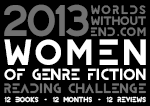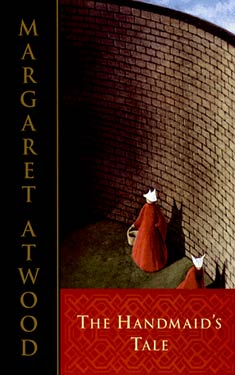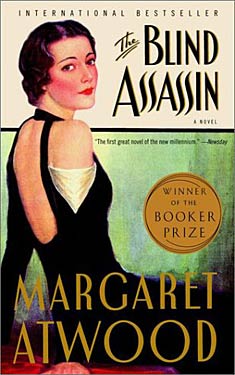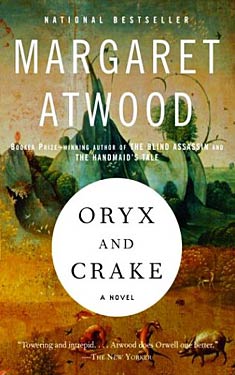WoGF Review: The Handmaid’s Tale by Margaret Atwood
 Guest Blogger and WWEnd member, Rob Weber (valashain), reviews science fiction and fantasy books on his blog Val’s Random Comments which we featured in a previous post: Five SF/F Book Blogs Worth Reading. Be sure to visit his site and let him know you found him here.
Guest Blogger and WWEnd member, Rob Weber (valashain), reviews science fiction and fantasy books on his blog Val’s Random Comments which we featured in a previous post: Five SF/F Book Blogs Worth Reading. Be sure to visit his site and let him know you found him here.
 The Handmaid’s Tale by Margaret Atwood is another one of those books everybody but me has read. It is one of the few works of science fiction (I’m not going to get into Atwood’s reluctance to classify it as such in this review) that has managed to appear on required reading lists for English literature classes. I’ve never read anything by Atwood before so I decided to pick this one up for the Women of Genre Fiction reading challenge. I think I can see why it has a certain appeal to both readers of genre fiction and those who prefer mainstream fiction. I found it to be a fascinating read but also a book full of very, very unpleasant things.
The Handmaid’s Tale by Margaret Atwood is another one of those books everybody but me has read. It is one of the few works of science fiction (I’m not going to get into Atwood’s reluctance to classify it as such in this review) that has managed to appear on required reading lists for English literature classes. I’ve never read anything by Atwood before so I decided to pick this one up for the Women of Genre Fiction reading challenge. I think I can see why it has a certain appeal to both readers of genre fiction and those who prefer mainstream fiction. I found it to be a fascinating read but also a book full of very, very unpleasant things.
In the near future plagued by environmental degradation and decreased human fertility, Christian fundamentalists manage to take over the United States. A war ensues and a new theocratic government is established. Soon they start stripping away rights from women and persecuting other religious groups. Our narrator, a woman renamed Offred, is separated from her husband and child and given to a high ranking member of the new regime. It is her job to provide him with the child his wife has been unable to conceive.
WoGF Review: The Handmaid’s Tale by Margaret Atwood
 Nadine Gemeinböck (Linguana) has been reading fantasy for as long as she can remember. She started blogging about books on SFF Book Review in 2012, hoping to keep track of what she read and how she liked it. The book blogging community has since helped her open her literary horizons and thanks to WWEnd, she is currently working her way through NPR’s Top 100. Her blogging resolution is to review more foreign language books and finally take the plunge into a big, swooping space opera.
Nadine Gemeinböck (Linguana) has been reading fantasy for as long as she can remember. She started blogging about books on SFF Book Review in 2012, hoping to keep track of what she read and how she liked it. The book blogging community has since helped her open her literary horizons and thanks to WWEnd, she is currently working her way through NPR’s Top 100. Her blogging resolution is to review more foreign language books and finally take the plunge into a big, swooping space opera.
 First sentence: We slept in what had once been the gymnasium.
First sentence: We slept in what had once been the gymnasium.
It is the world of the near future, and Offred is a Handmaid in the home of the Commander and his wife. She is allowed out once a day to the food market, she is not permitted to read, and she is hoping the Commander makes her pregnant, because she is only valued if her ovaries are viable. Offred can remember the years before, when she was an independent woman, had a job of her own, a husband and child. But all of that is gone now… everything has changed.
How does one go about reviewing a book that is not only considered one of the best ever written but was published a full year before one’s own birth? I suppose one doesn’t. Then again, what I do here in my little blogeress haven is really only putting my impressions into writing, not fully reviewing books (I believe that’s only possible with spoilers and I avoid them so you guys can enjoy the books I recommend in full). It took me a long time to finally read Margaret Atwood‘s probably most well-known book, The Handmaid’s Tale, and I’m happy to say that, again, the WWEnd Women of Genre Fiction Challenge gave me that last push.
Outside the Norm: Margaret Atwood’s The Blind Assassin and Oryx and Crake
Rhonda Knight is an Associate Professor of English at Coker College in Hartsville, SC. She teaches Medieval and Renaissance literature as well as composition courses. When she looked over last year’s reading list, she was shocked to see that only 17% of the authors she read were women. This blog will record her attempts to read authors that are generally considered out of the science fiction norm: women, persons of color, and non-U.S. and non-U.K. authors.
 Margaret Atwood has famously denied that she writes “science fiction,” claiming instead that she writes “speculative fiction,” a claim that always sounds less condescending coming from Harlan Ellison than it does from Atwood. This is probably because Ellison knows what he’s trying to define, and Atwood is trying to craft a definition that excludes her own writing from science fiction. According to Atwood, science fiction “is when you have chemicals and rockets” or “monsters and spaceships” or “talking squids in outer space.” For analyses of Atwood’s definitions, see Peter Watts, “Margaret Atwood and the Hierarchy of Contempt” and David Langford, “Bits and Pieces.”
Margaret Atwood has famously denied that she writes “science fiction,” claiming instead that she writes “speculative fiction,” a claim that always sounds less condescending coming from Harlan Ellison than it does from Atwood. This is probably because Ellison knows what he’s trying to define, and Atwood is trying to craft a definition that excludes her own writing from science fiction. According to Atwood, science fiction “is when you have chemicals and rockets” or “monsters and spaceships” or “talking squids in outer space.” For analyses of Atwood’s definitions, see Peter Watts, “Margaret Atwood and the Hierarchy of Contempt” and David Langford, “Bits and Pieces.”
My recent reading of two Atwood novels shows me that she can write science fiction badly and that she can write science fiction well. To be fair, I believe that she was trying to write bad science fiction in The Blind Assassin (2000). This winner of the Booker Prize is a multi-layered novel in which octogenarian Iris Chase Griffen recounts the life of her sister Laura Chase, the author of The Blind Assassin. This fictional book-within-a-book was published after Laura’s untimely death and gained a cult following. The sections of Atwood’s book alternate between Iris writing the story of the Chase girls’ youth and Laura’s novel. The plot of this internal novel is simple: in the 1930s and 40s a married upper-class woman has a clandestine affair with a lower-class man who is on the run. Both these characters are unnamed. He is most likely an active communist who is being pursued by the authorities. He makes his living by writing for science fiction pulp magazines. Most of these chapters follow the formula of the woman visiting the man at his current hideout where their post-coital pillow talk consists of the man entertaining her with science fiction stories he makes up on the spot. Their first foray into storytelling begins like this:
What will it be, then? he says. Dinner jackets and romance, or shipwrecks on a barren coast? You have your pick: jungles, tropical islands, mountains. Or another dimension of space—that’s what I’m best at.
Another dimension of space? Oh really!
Don’t scoff, it’s a useful address. Anything you like can happen there. Spaceships and skin-tight uniforms, ray guns, Martians with the bodies of giant squids, that sort of thing. (9)
It is significant that the character’s list mirrors the entities that Atwood herself references in interviews as I have shown above. Clearly, Atwood, as the writer of The Blind Assassin, and the male writer have a very low opinion of science fiction and its abilities to develop character or plot. For him, science fiction is about an Other (completely undeveloped) and cheap thrills, as their negotiations show:
Then you could have a pack of nude women who’ve been dead for three thousand years, with lithe, curvaceous figures, ruby-red lips, azure hair in a foam of tumbled curls, and eyes like snake-filled pits. But I don’t think I could fob those off on you. Lurid isn’t your style.
You never know I might like them.
I doubt it. They’re for the huddled masses. Popular on the covers though—they’ll writhe all over a fellow, they have to be beaten off with rifle butts.
Could I have another dimension of space, and also the tombs and the dead women, please?
That’s a tall order, but I’ll see with I can do. I could throw in some sacrificial virgins as well, with metal breastplates, and silver ankle chains and diaphanous vestments. And a pack of ravening wolves, extra. (9)
This negotiation ends with him beginning his story of the planet Zycron, which contains some of the ideas he discusses above. The story has too many plot details, many of them never expanded nor explored. While not all of his story ideas are completely cliché in execution, these two pieces of dialog demonstrate how Atwood pigeonholes science fiction.
Unfortunately for Atwood, the story of the lovers and their pulp pursuits are much more interesting than Iris’ main narrative which grows tedious after a while. Also, I figured out the ending surprises with more than 200 pages left which did not increase my interest in the stories Iris tells in either the past or the present. Also, I had trouble reconciling the characters of Iris in the past with Iris in the present.
 Oryx and Crake (2003) shows that Atwood can write good science fiction; however, she would call it speculative fiction, or writing “based on rigorously-researched science, extrapolating real technological and social trends into the future” (Watts 2). And I thought that was what science fiction was. Atwood creates an interesting post-apocalyptic world in which there is one human survivor who calls himself Snowman. Snowman is the caretaker of a race of bio-engineered humanoids, who were created by his friend Crake. According to Crake, all aggression, greed, and competition have been eliminated in this race. They have an advanced life cycle, becoming “adults” after only a few years. They live a pre-lapsarian lifestyle and eat roots, fruits, and grass. Snowman serves as kind of prophet for them. He teaches them about the flotsam they discover from the previous civilization, telling them if it is useful or dangerous.
Oryx and Crake (2003) shows that Atwood can write good science fiction; however, she would call it speculative fiction, or writing “based on rigorously-researched science, extrapolating real technological and social trends into the future” (Watts 2). And I thought that was what science fiction was. Atwood creates an interesting post-apocalyptic world in which there is one human survivor who calls himself Snowman. Snowman is the caretaker of a race of bio-engineered humanoids, who were created by his friend Crake. According to Crake, all aggression, greed, and competition have been eliminated in this race. They have an advanced life cycle, becoming “adults” after only a few years. They live a pre-lapsarian lifestyle and eat roots, fruits, and grass. Snowman serves as kind of prophet for them. He teaches them about the flotsam they discover from the previous civilization, telling them if it is useful or dangerous.
Before he became the prophet of the Crakers (as he calls them), Snowman was Jimmy, who grew up in an enclosed corporate compound called OrganInc Farms. His father was a prominent bio-engineer working on the Pigoon Project, which created pigs that would grow “an assortment of foolproof human-tissue organs” for transplanting into humans (22). These compounds were mostly self-contained with malls, schools, hospitals, etc. that served the needs of the employees and their families. The compounds are connected by tube trains. The areas in between are called pleebland (read pleeb-land), where the mass of humanity lives: economically disadvantaged, diseased, and the ultimate consumers for the products and techniques created in the compounds. This sociological layout reminds me very much of the world Marge Piercy creates in He, She and It, except that Piercy’s economy is based on computer technology and virtual reality instead of bio-engineering.
Snowman’s narrative covers just a few days in his present as he tries to survive in this devastated landscape where food is scarce and new predators, which were former science projects housed in labs, roam. There are snats (a cross between snakes and rats) and wolvogs (a cross between a dog and a wolf). Also, the pigoons have become carnivores and are getting smarter. The bulk of the past story is about Jimmy, how he came to be a survivor, his love for Oryx, and his friend Crake’s ambition to create better human beings. The end of the book finally shows the readers how the rest of humanity met its demise and the roles that Jimmy, Oryx and Crake played in that disaster.
This book was very enjoyable. The science seems science-y enough, and her portrayal of “reality” broadcasts over the internet, where one could find the Noodie News, open heart surgeries, live coverage of executions, and, of course, enough pornography to cover any viewer’s choices or fetishes, seems especially prescient. The plot is well-paced, and both the present and past events are interesting, so I never found myself wishing I could move on to the next time period, like I did with The Blind Assassin. While I cannot say that I liked The Blind Assassin as much as I liked Oryx and Crake, Atwood writes beautifully and is a pleasure to read. I plan to read The Year of the Flood and The Handmaid’s Talec later this year for this blog.



















 Full Details
Full Details

